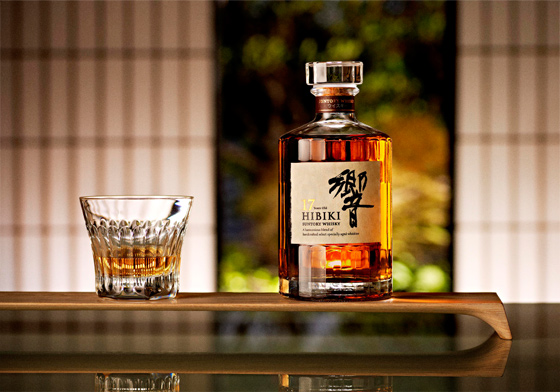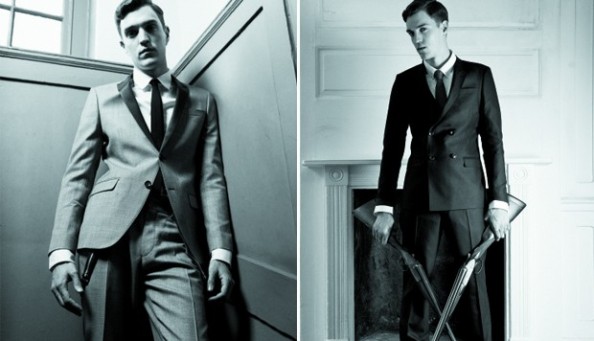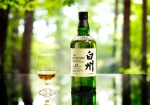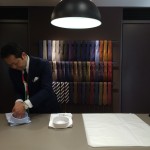It may not seem like it but for a while Japan was taking on tech and auto behemoths, pioneers in the industry and beating the big players at their own game. Whether it was Sony with the Walkman or Toyota with high build quality and fuel efficiency, Japan was showing the West how it was done. But unknown to all but a minority of well-dressed, swank-living gentlemen, another secret front was developing- Japan was taking elements of Western culture: the Savile Row suit (In kanji: ‘Sebiro’ is a direct translation of the English name – more on that in a bit), Scottish Whiskey and American denim and re-inventing them with the same artisanal dedication to Japanese precision found on objets d’art like Grand Seiko. Japan was once again beating the West at their own game.
How Japan Saves Western Culture by Appropriating & Improving on it
 Re-inventing Whiskey: Hibiki
Re-inventing Whiskey: Hibiki
Earlier this year, Osaka-based Suntory (of Lost in Translation fame but already world renowned before Bill Murray’s movie had launched in the theatres) shocked the world by announcing acquisition of proudly American brands Jim Beam and Maker’s Mark but lest you misunderstand their intention as some untoward occupation of quintessential Americana like beer and alcohol, one has to understand the foundations of Japanese artisan philosophy is that of complete mastery. Theirs’ is the ability to absorb and improve everything from cocktails to couture. When it comes to whiskey, Japan has close to a hundred years of heritage.
 In 1923, Shinjiro Torii envisioned a whisky filled with the essence of Japanese nature and hand-crafted by artisans through a patient process of enhancing the work of nature. He dreamt of creating subtle, refined, yet complex whisky that would suit the delicate palate of the Japanese and enhance their dining experience. Inspired by traditional Scottish whisky, Torii envisioned a Japanese approach by choosing a terrain and climate completely different from those of Scotland. Its paragon representative? The Hibiki.
In 1923, Shinjiro Torii envisioned a whisky filled with the essence of Japanese nature and hand-crafted by artisans through a patient process of enhancing the work of nature. He dreamt of creating subtle, refined, yet complex whisky that would suit the delicate palate of the Japanese and enhance their dining experience. Inspired by traditional Scottish whisky, Torii envisioned a Japanese approach by choosing a terrain and climate completely different from those of Scotland. Its paragon representative? The Hibiki.
Seductive, blossoming and enigmatic, Hibiki celebrates an unrivaled art of blending, fine craftsmanship and a sense of luxury from the House of Suntory. Hibiki is not only Japan’s most highly awarded blended whisky, but among the most prestigious and honoured whiskies in the world. It stands shoulder to shoulder with the relatively affordable Yamazaki and Hakushu range.
 Re-inventing Denim
Re-inventing Denim
Seeing has how the Japanese isles are mostly liveable costal regions flanked by unforgiving mountainous terrain, history records Ukita Kideie, Daimyo of Okayama initiating land reclamation projects to make more land for a bourgeoning population Since rice crops don’t fair well in salt water (particularly sea-soaked lands), cotton became the crop of choice for the region in the 16th century.
 Okayama prefecture was already a production capitol for traditional Japanese couture like the sanada-himo (traditional ribbons), socks, kokura-obiji (kimono belt) and hakama (Samurai pants) but when foreigners started visiting the isles in the late 19th century, traditional Japanese garb became less popular as natives intimated with exotic and unique ensembles, beginning first with the standardised uniforms across Japanese universities and then with the arrival of American GIs at the close of WWII, cotton-spun denim became the primary product of choice. By 1940, the foundations of Big John were laid, by 1950s they had built their first denim looms by hand and by 1965, the first Kojima produced denim products became available to the territory.
Okayama prefecture was already a production capitol for traditional Japanese couture like the sanada-himo (traditional ribbons), socks, kokura-obiji (kimono belt) and hakama (Samurai pants) but when foreigners started visiting the isles in the late 19th century, traditional Japanese garb became less popular as natives intimated with exotic and unique ensembles, beginning first with the standardised uniforms across Japanese universities and then with the arrival of American GIs at the close of WWII, cotton-spun denim became the primary product of choice. By 1940, the foundations of Big John were laid, by 1950s they had built their first denim looms by hand and by 1965, the first Kojima produced denim products became available to the territory.
 More brands spring up today but of note, Takashi Tateno of Workers approximates almost all the dominant garments of American work wear culture from the 1900s to 60s: railroad jackets dusters, flannel shirts and even double-kneed pants. More importantly, he’s focused on the uniquely American tools and techniques used by Americans themselves back when manufacturing and exports was where the United States flexed their industrial prowess (a job sadly bequeathed to China).
More brands spring up today but of note, Takashi Tateno of Workers approximates almost all the dominant garments of American work wear culture from the 1900s to 60s: railroad jackets dusters, flannel shirts and even double-kneed pants. More importantly, he’s focused on the uniquely American tools and techniques used by Americans themselves back when manufacturing and exports was where the United States flexed their industrial prowess (a job sadly bequeathed to China).
 Tateno sought plans, patterns and archives of defunct manufacturers like Crown and W.M. Finck & Co. and also conducted his own research by dissecting vintage garments to study their construction, eventually launching his now eponymous company. No expense spared, Tateno owns his own heritage riveting machine plus a myriad of old sewing machine accessories so his own factories can produce era-specific collections in exact specifications thanks to the very same tools that made them.
Tateno sought plans, patterns and archives of defunct manufacturers like Crown and W.M. Finck & Co. and also conducted his own research by dissecting vintage garments to study their construction, eventually launching his now eponymous company. No expense spared, Tateno owns his own heritage riveting machine plus a myriad of old sewing machine accessories so his own factories can produce era-specific collections in exact specifications thanks to the very same tools that made them.
“These were produced at a time when American workers were the most knowledgeable and skilled in the world.” – Tateno
The cottage industry in is literally the last place on earth where these high level sewing skills still exist and it’s where Tateno could find the artisans to fulfil his vision for the perfect American garment. .

The concept of ‘Sebiro’ is so pervasive that even popular mass brands like Superdry collaborate with Row-trained tailors like Timothy Everest to create ‘Sebiro collections’.
Re-inventing Savile Row: Sebiro せびろ背広
The word ‘bespoke’ was coined on the Row itself in the 19th century when tailors earmarked specific bolts of cloth for individual customers for his suit- The fabric was “be spoken for”. Today, Sebiro is a truncation of the English ‘Savile Row’, serving as linguistic shorthand in Japanese for ‘business suit’ and no longer confined to just tailored garments from the Row; instead, it encompasses suits of both English and Neapolitan cuts.
 This is a heritage that goes back further than whiskey or denim, in fact, Japanese royalty were customers of Henry Poole on the Row since 1871 and its a fascination which endures today. Eschewing the traditional kimono for the mid-19th century British uniform of choice was a natural progression given the general perception of luxurious indulgences and obvious craftsmanship enjoyed by all manner of European royalty (primarily Edward Prince of Wales).
This is a heritage that goes back further than whiskey or denim, in fact, Japanese royalty were customers of Henry Poole on the Row since 1871 and its a fascination which endures today. Eschewing the traditional kimono for the mid-19th century British uniform of choice was a natural progression given the general perception of luxurious indulgences and obvious craftsmanship enjoyed by all manner of European royalty (primarily Edward Prince of Wales).
But post WWII, war-time resource issues and the corresponding rise of industrialisation led to rapid growth of ready-to-wear manufacturers putting bespoke tailors and the Savile Row itself at risk: luxury and good-taste were now symbols of aristocracy and elitism and with the dissolution of the Empire and the affordability of ready-to-wear, the elegance of the Row (and its tradition for produce of such bespoke beauty) was adopted by fashion houses with factory produced garb instead.
 Today, the next generation of bespoke tailors hail from none other than the land of the rising sun. Even as dominant suit making cities like London and Hong Kong face a crisis of a dying, irreplaceable shortage of good cutters, the number of Japanese tailoring apprentices are at an all time high.
Today, the next generation of bespoke tailors hail from none other than the land of the rising sun. Even as dominant suit making cities like London and Hong Kong face a crisis of a dying, irreplaceable shortage of good cutters, the number of Japanese tailoring apprentices are at an all time high.
Elite Japanese tailors of relative youth (30s compared to their 50 to 60 years old counterparts on Savile Row and in Naples) like Noriyuki Ueki adopt Italianesque names like Ciccio (suggested by his own master when he couldn’t pronounce his Japanese name), casually tossing “buon girnos” and serving espressos while readily commanding fees equivalent if not more than the visiting Neapolitan masters themselves. They’re mostly under 40 and while there are only a handful now, more intern at fine tailoring sartorias in Naples while native Neapolitans looking to pick up the labour intensive trade continue to be in short-supply.
There’s some historical irony that while most of the business world has embraced the American concept of “Business casual”, Japanese work attire remains firmly entrenched in the realm of tailored suiting. It’s here that brands like Ring Jacket and Tomorrowland Co. peddle a version or adaptation of Vincenzo Attolini’s original vision for suiting- natural shoulders and blazers with that undefinable quality of sprezzatura. Perhaps not too far off in the future, it looks like purest expression of Western gentlemanly pursuits might be found in the Far East.
- Sebiro & Co Japanese tailoring
- Sebiro & Co Japanese tailoring







November 18th, 2015 → 8:08 am
[…] Inspired by traditional Scottish whisky, Torii envisioned a Japanese approach by choosing a terrain and climate completely different from those of Scotland. Its paragon representative? The Hibiki. [The story of Sebiro and how Japan reinvents the West via TheMonsieur.com] […]